To reach out to voters, one candidate in Salina is having people scan a code
While yard signs are a common sight during campaign season, one sign in Salina this year is a bit different, featuring only a scannable QR.
Invented in 1994 as a way to label car parts at a manufacturer in Japan, quick-response, or QR codes, are used in today's society as a quick way for a scanner, phone or other optical device to process encoded information.

For current City Commissioner Trent Davis, who's also running for re-election this year, this QR code on a sign is being used to gather information from the public that could inform him of the views of the electorate.
When someone looks at the code with something like a smartphone, it directs the scanner to a link to a survey paid for by the Davis campaign, asking the voter to rank five issues in the City of Salina by order of importance.
Why is a Salina City Commission candidate putting up QR signs?
Phil Black, who himself has run for and been elected to various local political offices in Salina, has been helping Davis with his campaign and said this idea came from a discussion with a University of Kansas student from Salina, Luke Stanford.
"(He previously) worked on my campaign," Black said. "The three of us were just meeting and having dinner and Luke...said (we) ought to do a QR code."
Davis and Black decided to run with the idea, saying it was something new and unique that people in Salina hadn't seen before.
"I've had people on Facebook (tell) me that's it brilliant," Black said.
Davis also has traditional campaign signs, with his name on it, but Black said by having another sign it offers more ways for voters to engage with the campaign.
"(Obviously), if you're in a car, you're not going to be able to scan the code," Davis said.
But the code certainly draws attention to eyes as people drive by or as they walk or bike by, offering them the opportunity to stop and scan it.
Davis said this also speaks to how people are receptive to newer and different ways to engage with a candidate.
"It just goes to show that in central Kansas...there are people daring to take a chance (on technological advancements)," Davis said.
More: Former Oakdale Park pool, skating rink to be demolished
What is Davis hoping to learn from the QR survey?
As a current commissioner and as a candidate for the upcoming commission, Davis said he always wants to hear from people who are not like him.
"It took me a while to learn that (listening is) much more valuable than (talking)," Davis said.
He said he likes to listen to people from all backgrounds and walks of life, because it may give him information or a viewpoint he hadn't thought of.
"Everybody's opinion is valuable," Davis said.
Looking at what is happening in Salina, Davis said he has ideas about what is important, but he doesn't assume to know everything that is going on. Using this QR survey, he hopes to better understand what others in the community might think is important.
This article originally appeared on Salina Journal: Salina City Commission candidate using QR technology to reach voters

